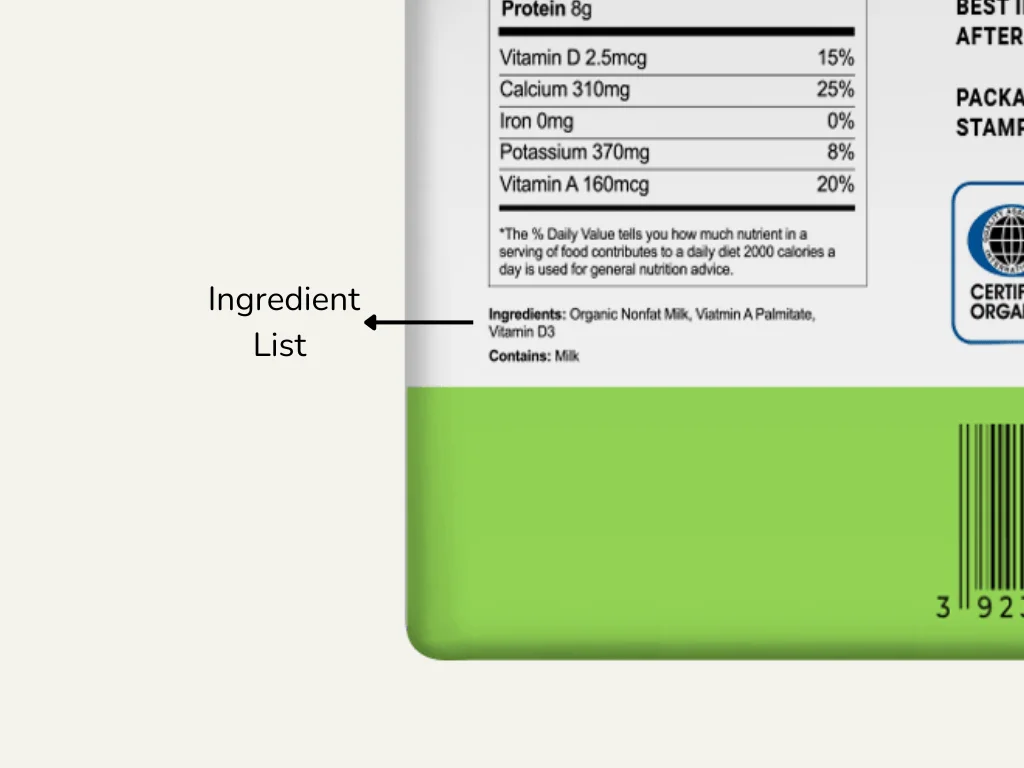Crafting an ingredient list for your food product is an intricate dance between regulatory compliance and consumer transparency. Amidst the labyrinth of FDA documents and guidelines on food labeling, manufacturers might feel daunted. However, mastering how to make ingredient labels is not just about ticking regulatory boxes – it’s about fostering a trustworthy and transparent relationship with your consumers.
This article demystifies this process, offering easy and actionable steps to create FDA-compliant ingredient labels. Whether you’re drafting an ingredient statement for a gourmet bakery item or a detailed meal kit, we’ll guide you through ensuring your labels meet the highest standards of accuracy and compliance.
Summary
- List Ingredients by Weight: Start by listing all ingredients in descending order based on their weight. This is a fundamental FDA requirement, ensuring that consumers understand the predominance of each ingredient in the product.
- Use Consumer-Friendly Names: Opt for common names that are easily recognizable to consumers. For example, use “sugar” instead of “sucrose” to ensure clarity and familiarity.
- Include All Sub-ingredients: If any ingredient is a compound of several items, list these sub-ingredients in parentheses. This detail is crucial for transparency and informs consumers about every component in the product.
- Highlight Additives and Preservatives: Clearly mention any additives or preservatives used in the product. This information helps consumers make informed choices, especially those with dietary restrictions or allergies.
- Choose the Right Font: Ensure the ingredient list is legible by using a clear, easy-to-read font. The FDA recommends a minimum font size of 1/16 inch in height for ingredient lists to ensure readability.
By following these steps, you can create clear, accurate, and FDA-compliant ingredient lists that foster consumer trust and meet regulatory standards.
The Basics of Creating an Ingredient Label

In the bustling world of the food and beverage industry, ensuring that every product’s ingredient label is clear, accurate, and FDA-compliant is essential. Let’s delve into the foundational aspects of crafting these labels.
The Order of Ingredients
When it comes to listing ingredients, the primary rule is straightforward: ingredients should be enumerated in descending order based on their weight. This means the ingredient that constitutes the largest portion of the product’s total weight is listed first, followed by the next heaviest, and so on. It’s crucial to remember that this order is determined by weight, not volume. As an example, if you’re crafting a bakery item, the primary ingredient might be flour, followed by sugar, and then butter.
Moreover, ingredients should be denoted using their universally recognized or “common” names. For instance, “sugar” is preferred over “sucrose”. And if an ingredient comprises its own set of sub-ingredients, it should be encapsulated in parentheses.
An illustrative example would be a recipe incorporating chocolate chip cookie dough. It could be represented as “Cookie Dough (Wheat Flour, Sugar, Chocolate Chips (Cocoa Mass, Sugar, Cocoa Butter, Soy Lecithin), Butter, Eggs, Vanilla Extract, Baking Soda)”.
Additions
Beyond the primary ingredients, there are often additives or secondary components that need to be included in the ingredient list. These can range from preservatives that extend the product’s shelf life to flavor enhancers that elevate the taste.
When listing these additions, it’s essential to use their common names. For instance, instead of using a chemical name, you might list “natural vanilla flavoring” or “citric acid as a preservative”. Being transparent about these additions helps businesses cater to informed consumers who are keen on understanding what they consume.
Exceptions
While the general rule is to list ingredients in descending order of weight, there are exceptions to consider. Certain ingredients can be umbrellaed under generic terms like “flavorings” unless they are potential allergens. Ingredients that constitute 2% or less of the total weight of the product can be listed at the end, often following a statement like “Contains 2% or less of…”.
Additionally, certain spices might not need to be individually named and can be collectively labeled as “spices.” This is pivotal for secret blends, ensuring the magic of your product remains undisclosed. However, if the product is a specific spice blend, individual spices should be listed. It’s always good practice to stay updated with FDA guidelines to ensure that your ingredient labels are both accurate and compliant.
See How FoodLabelMaker Can Help You
Creating Your Ingredient List Step-by-step
Crafting an FDA-compliant ingredient list for your food product might seem like a daunting task, but with a systematic approach, it becomes far more easy. Here’s a step-by-step guide to help you navigate the process, ensuring your labels are both accurate and in line with FDA guidelines. We will be using a chocolate cake as an example in these steps.
Before diving into how to make ingredient labels, it’s essential to familiarize yourself with the FDA’s food labeling guide. This will give you a comprehensive understanding of the requirements and expectations.
Step 1: Weigh out Your Ingredients and List them in Descending Order
As per FDA guidelines, ingredients should be listed in descending order of their weight. Begin by weighing each ingredient. This step is crucial as it forms the basis of your ingredient statement and ensures the integrity of your ingredient list. The heaviest ingredient will be listed first, followed by the next heaviest, and so on. This approach ensures that consumers get a clear picture of the product’s composition. For instance, for our chocolate cake, precise measurements like 2 cups of flour, 1 cup of sugar, and half a cup of cocoa lay the groundwork for an accurate list.
When listing ingredients, it’s essential to use names that are easily recognizable and understood by the average consumer. This means opting for the common or usual name of the ingredient. So, when listing ingredients for a chocolate cake, instead of using “Theobroma cacao”, it’s more consumer-friendly to simply list it as “cocoa”. This ensures that consumers can easily recognize and relate to the familiar ingredients used in the cake.
Step 2: Include Sub-ingredients
If an ingredient is made up of multiple components, known as sub-ingredients, they should be marked with a parenthesis when added to an ingredient list.
Therefore, if your chocolate cake uses a specific mixture, like a chocolate ganache, break it down. So it would be stated as, “Chocolate Ganache (Heavy Cream, Chocolate, Butter)”.
Step 3: Address Additives, Preservatives and Exceptions
Once the primary ingredients are listed, it’s time to focus on additives, preservatives, or secondary components. These should be clearly mentioned, with their purpose highlighted. This maintains a sense of transparency for your product and informs the buyer about any additives or preservatives they might have not been aware of. A chocolate cake might contain additives or preservatives to enhance shelf life or flavor, and must be mentioned clearly in the ingredient list. For instance, “Emulsifier (Soy Lecithin)”.
In FDA regulations, there’s a provision that allows ingredients constituting a minor part of the product, specifically those that make up 2% or less of the total weight, to be listed at the end of the ingredient list. This is particularly useful for ingredients that are used in very small quantities but are still essential to the product. In the context of a chocolate cake, if you’re using a small amount of vanilla extract or a specific essence that falls under this weight threshold, you can list it at the end of your ingredient list, introduced with “Contains 2% or less of Vanilla Extract”.
Step 4: Handle Spices and Flavorings
Certain spices, flavorings, and colors can be collectively listed without specifying each one, unless they have allergenic potential.
If your chocolate cake has a blend of spices or flavorings, they can be collectively listed as “spices” or “flavorings”, unless a specific one is a known allergen.
Step 5: Allergen Information and FDA Terminology
Ensure that any allergens present in the product, such as milk, nuts, soy, or wheat, are clearly identified. Common allergens demand prominence. Whether they’re standalone or part of a compound ingredient, they should be conspicuously mentioned. This isn’t merely a regulatory mandate but a pivotal step in consumer safety. For a chocolate cake with nuts or dairy, ensure allergens like “milk” or “almonds” are clearly identified, either within the ingredient list or in a separate allergen statement.
For certain ingredients, the FDA has specific naming conventions. Ensure you’re using the approved terminology. When listing sweeteners for your chocolate cake, ensure you’re using FDA-approved terminology. For instance, if using a specific syrup, list “corn syrup” rather than a brand or abbreviated name.
Step 6: Review and Update Regularly
Ingredient sources and formulations can change. Regularly review and update your ingredient lists to ensure ongoing compliance with FDA regulations. Chocolate cake recipes can evolve, and so can recipes in general. Whether you’re trying a new source of cocoa or adjusting sugar levels, regularly review and update your ingredient lists to ensure they remain compliant with FDA regulations.
By following these steps and utilizing our ingredients list checklist, you can simplify the process of creating an FDA-compliant ingredient list. Remember, the goal is to provide clarity to consumers while adhering to regulations.
Formatting Your Ingredient List
Once you’ve compiled the ingredients for your food product, the next crucial step is learning how to make ingredient labels to sell. This involves formatting them in a manner that’s clear to consumers and compliant with regulations. Proper formatting goes beyond aesthetics; it’s about ensuring that your product ingredient labels are easily readable and adhere to FDA standards.
- Font and Size: Clarity is king. Choose a font that’s legible and of a size that can be easily read. Avoid overly decorative fonts that might confuse readers. The FDA has specific guidelines on minimum font sizes based on the size of the packaging, so ensure you adhere to these. The physical dimensions of your ingredient label are also just as crucial as its content. Ensure it’s proportionate to your product packaging and remains legible.
- Bold Main Ingredients: If your product has main ingredients that encompass sub-ingredients, consider bolding the main ingredient for clarity. For instance, in a chocolate cake mix, “Chocolate Chips” could be bolded, followed by its sub-ingredients in regular font.
- Use Parentheses for Sub-ingredients: As previously mentioned, if an ingredient has its own set of components, encapsulate them in parentheses. This ensures clarity on what order ingredients are listed on a recipe.
- Consistent Terminology: Ensure that you use consistent terminology and common names throughout.
- Allergen Highlighting: Allergens deserve prominence. Consider bolding them or employing a separate label to ensure they’re unmistakable and stand out. This is a crucial aspect of how to make an ingredient label that prioritizes consumer safety.
- Use of Delimiters: Differentiation between ingredients is crucial. Bullet points or commas can serve as effective delineators. Separating each ingredient with a comma also maintains clarity, such as sub-ingredients being separated by commas within the parentheses.
Conclusion
The journey through FDA regulations might seem arduous, but with the right compass, it’s a navigable path. Ingredient labeling transcends compliance – it’s a testament to your brand’s commitment to transparency and consumer safety.
Fortunately, there are software solutions designed to simplify this process.
Navigating FDA regulations can appear daunting, yet with the right guidance, such as an ingredients list label generator, it becomes a manageable journey. Ingredient labeling is more than just compliance; it reflects your brand’s dedication to transparency and consumer safety.
Thankfully, software solutions exist to ease this process. Tools like Food Label Maker provide how to make ingredient labels for food guides and templates, facilitating the creation of FDA-compliant ingredient lists. This ensures your labels are both precise and professional.
By utilizing these resources and staying well-informed, you’re equipped to confidently introduce your product to the market, with the assurance that your ingredient labels, crafted to sell, adhere to the highest standards.
By leveraging such tools and staying informed, you can confidently present your product to the market, knowing that your ingredient statement meets the highest standards.



